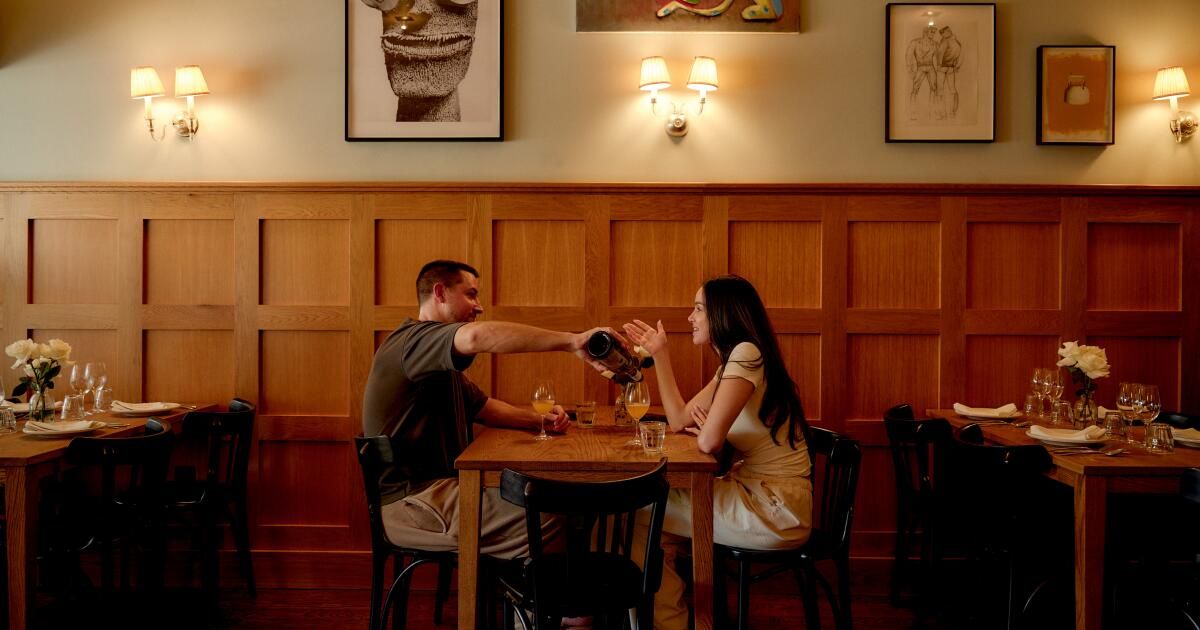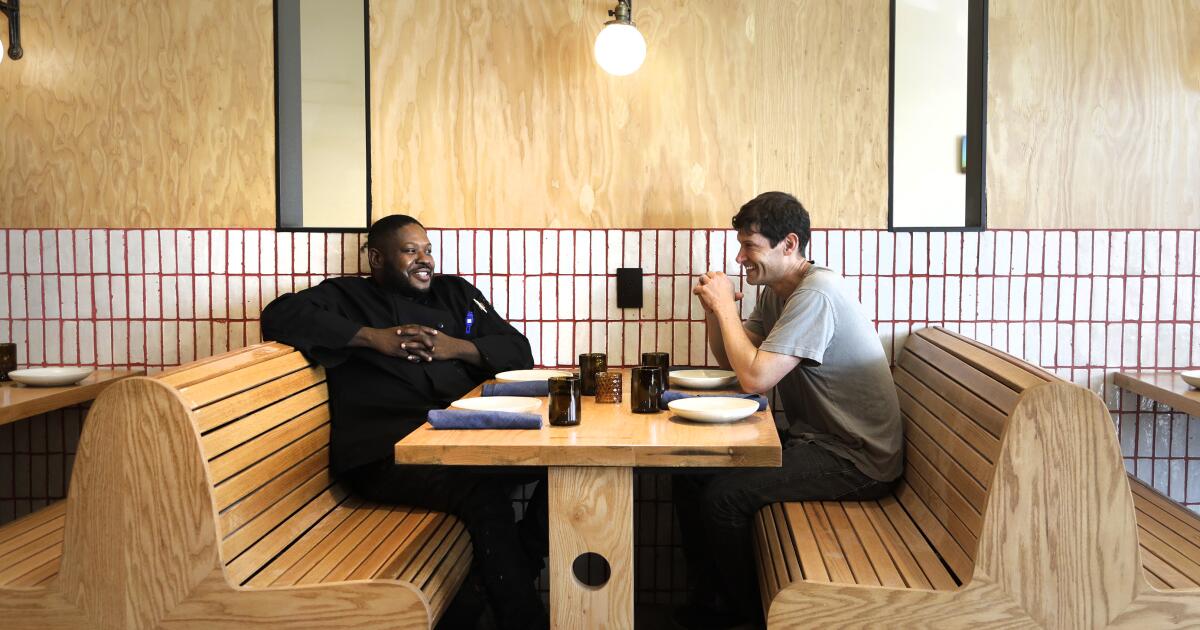For decades, Stir Crazy was a coffee shop, a business wedged between the endless connected restaurant, retail and office buildings of Melrose Avenue, interrupted only by cross streets.
Dino Trucco took over the place in 1994, ripping out the Formica tile decor of the previous occupant, named Java Man, and installing thick wood paneling to surround his neat rows of log-cabin-like tables.
Then time practically stopped there for 30 years.
Macklin Casnoff grew up in Los Angeles and was a regular at Stir Crazy. Over the years, the espresso served at its counter never became a third-wave phenomenon. The interior became scruffy and, as a gathering place for generations of writers, damp with the fog of loose stories left unfinished or unfulfilled beneath its roof.
Stir Crazy owners Macklin Casnoff, let, Harley Wertheimer and Mackenzie Hoffman.
(Shelby Moore/For The Times)
But something about the store’s size and community value had resonated with Casnoff, so much so that he proposed the idea of opening a restaurant there with Mackenzie Hoffman. The two hospitality professionals had been working together during the pandemic at Jill Bernheimer’s wonderful Domaine LA wine shop just down the street.
In 2022, they reached out to Trucco, who decided he was ready to retire. Together with music industry veteran Harley Wertheimer as a third partner, they signed a new lease and set out to transform everything about Stir Crazy except its name.
The result: a minimalist space with maximum impact. A warm renovation that respects form and function. A casual, Euro-Californian menu. An incredible wine program led by Hoffman. In the year since the trio set up shop, an old spot has been reborn with a new soul.
Small restaurants have a particular psychology in cities, especially in a city as boundless as Los Angeles. I don’t mean the bustling joints that equate crowding and claustrophobia with exclusivity, but the little sanctuaries where we can feel contained, safe. The rooms that shelter our bodies and minds from the big world for a couple of hours.
In its new configuration, Stir Crazy’s dining room spans 500 square feet. The eight tables that surround it, including an eggplant-colored banquette, seat 25. Square white oak panels adorn the lower half of the walls. Above them hang double sconces with pleated shades and artwork—sketches, portraits, prints—either hung or pinned up without a frame.
What a list of details doesn’t convey are the sensory dimensions. There’s a sweetness to the communal bubble. It speaks to the parts of our brains that loved to retreat into a treehouse or build a fort out of blankets under the furniture, only now we’re grown-ups at comfy tables with smart plates and skin-contact Alsatian Silvaner swirling in our glasses.
Another calming element, in relation to the restaurant's kitchen proportions, is that the menu and by-the-glass lists are concise. Less deliberation, less angst.
1

2

3

4

1. The reservation system at Stir Crazy. 2. Anchovies with herbs and hazelnuts. 3. A dish called “tomatoes three ways.” 4. Sausage with potato salad and mustard. (Shelby Moore/For The Times)
The dishes served are about a dozen in number. Some could be considered starters or appetizers. Start with a round of very salty Iberian ham and Parmigiano Reggiano cut into chunks, a fun cippolini onion dip with chips, and a delicious plate of sliced anchovies sprinkled with hazelnuts and on a green sauce with a hint of tarragon. If you're eating light, you can happily order a repeat of these dishes and be done with it.
Look a little deeper and the choices speak to a certain restaurant-loving Los Angeles crowd: the seasonal, local ingredients, the friendly mix of Italian, Japanese and Korean flavors. As summer was winding down at a recent dinner, blackberries added juicy acidity to tuna tartare with shaved fennel. Nectarines paired so well with brown butter and shiso on a raw fish dish that the fish almost became superfluous. Pearls of fregola sarda floated on the palate in satisfying contrast to the clayey, basil-scented ratatouille.
There was also a nice sculptural tangle of crisp, all-vegetable green beans. I prefer them slow-cooked until tender (my Southern roots are showing) and I ate them around the beans to reach for the lemon-flavored tonnato-seared cucumbers and grated bottarga.
The kitchen team, led by Caroline Leff (who worked with Hoffman at the short-lived Onda in Santa Monica), keeps a few perennials on rotation. Among them is a celery salad with walnuts, goat cheese and raisins that swings between sweet and salty, soft and crunchy. For the main course, a lightly spiced German sausage from Mattern's Deli in Orange County comes with a mound of creamy Japanese-style potato salad topped with Kewpie mayo and a generous dollop of mustard.

The kitchen team is led by Caroline Leff, who worked with Mackenzie Hoffman at the short-lived Onda in Santa Monica.
(Shelby Moore/For The Times)
Both dishes are absolutely delicious and are the kind of combinations I could eat once a week. That is precisely the point.
And what about by the glass: a German pinot blanc, with herbs and peach flavour? A fresh, citrusy trebbiano from Abruzzo? An Austrian zweigelt with cherries in the centre? Not counting dessert wines, the selection is usually less than ten. It's enough because the staff asks the right questions about your tastes and is unusually perceptive with recommendations.
That’s Hoffman’s department, and she writes one of my favorite wine lists in Los Angeles. Bound pages with endless lists of facts about producers and years overwhelm or bore most of us. I look for a way in, something that makes me want to ask questions. Hoffman, for example, adds subtle, intriguing comments in bold about the availability of some bottles: “last call,” “new,” “restock.” Why are they popular, or special, or available now? They’re little introductory bits to give the diner a conversation starter, if you like, and something more than the standard approach of asking, “What kind of wine do you like to drink?”
Hoffman compares the choice to keep 300 bottles on hand in a restaurant of this size to that of putting together his record collection for display. “I’ve collected all these artists, these producers, these farmers, since I started working in restaurants at 18,” he said in an interview. “It’s another way of telling stories. A winemaker might only make 30 to 40 vintages. If I’ve followed someone’s work for 10 years, I’ve seen almost a third of their life’s work, a third of their life’s harvest.”
Talk to Hoffman enough and you’ll recognize that his wine mix leans toward some of the mottos of the day: natural, biodynamic, low-intervention. He’ll approach a table with two or three bottles to describe styles, garner interest and observe reactions. He remembers what he likes when he comes back.

Stir Crazy regulars appreciate the quirky hours: Open Monday through Friday only.
(Shelby Moore/For The Times)
That is to say, the restaurant has a growing group of regulars. We accept the odd hours, Monday through Friday. Parking is notoriously difficult on the Melrose corridor on weekdays, and giving restaurant staff days off on Saturdays and Sundays seems shamelessly civilized.
Part of the reward of the Stir Crazy scale is also perceiving tangible mood shifts: more calm and quiet earlier in the week, more bottles and fuss later. Maybe a dish slides toward fall ingredients. Maybe Switzerland’s obscure white wine has run out and instead you’re sipping an original Central Coast Chardonnay with captivating notes of salted almond.
In such a small place everything seems significant.
Go mad
6903 Melrose Ave., Los Angeles, Instagram.com/stircrazy.la
Prices: Most appetizers cost between $6 and $18, small plates between $16 and $24, main dishes between $26, desserts between $6 and $18.
Details: Open Monday to Friday from 4pm to 11pm. Wine and beer. Street parking.
Recommended dishes: Anchovies with herbs and hazelnuts, celery salad, seasonal and raw salads, sausages with potato salad. Co-owner Mackenzie Hoffman is one of Los Angeles' great wine professionals; a conversation with her will lead you to delicious and intelligent drinking.












